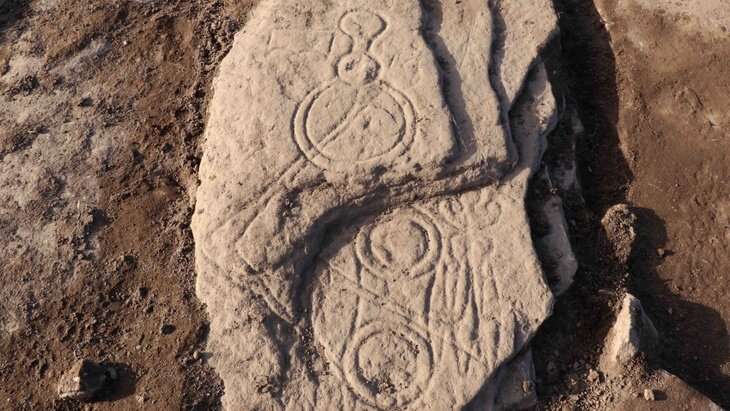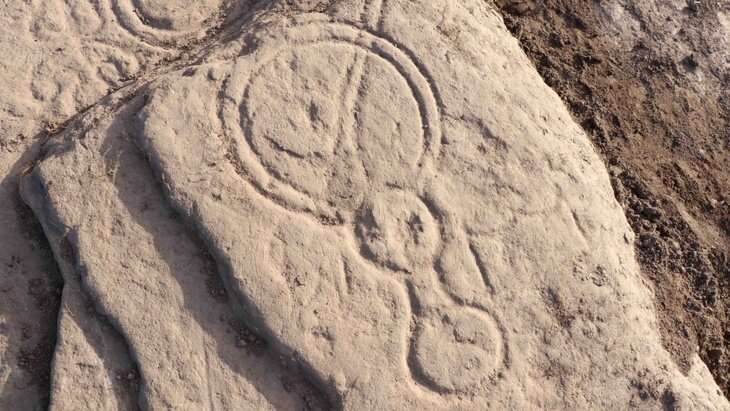
The location of one of the most significant carved stone monuments in Scotland has been discovered by archaeologists.
A team from the University of Aberdeen hit upon a 1.7 meter-long stone in a farmer's field while conducting surveys to try and understand the important landscape of Aberlemno, near Forfar.
The most famous of the unique standing stones in the area is a cross-slab which is thought to depict scenes from a battle of vital importance to the creation of what would become Scotland.
The Comparative Kingship project was funded by the Leverhulme Trust and the archaeologists were conducting surveys of the ground early in 2020 to better understand the history of the existing stones.
There were anomalies which looked like evidence of a settlement when they took the equipment over the ground.
A small test pit was dug to see if the remains of any buildings were present but to their surprise, the archaeologists found a carved Pictish symbol stone, one of only 200 known.
Their efforts to establish the character of the stone and settlement were hampered by subsequent COVID lockdowns and it was several months before they were able to verify their find.
Over the last few weeks, the team has excavated part of the settlement and removed the stone from its resting place to find out more about the stone and its setting.
Professor Gordon Noble says that stumbling upon a stone during an archaeological dig is very unusual.
At the University of Aberdeen, we have been leading Pictish research for the last decade but never found a stone symbol.
There are around 200 monuments. By the time we get to analyze them, a lot of what surrounds them has already been disturbed.
To find something like this while digging a small test pit is amazing and we couldn't believe our luck.

The benefits of making a find in this way are that we can do more detailed work. We can date the layers and extract more detailed information without losing vital evidence.
We thought we'd uncover a little bit more before we headed off for the day. We saw a symbol. There was a lot of screaming. There was more screaming and a little bit of crying after we found more symbols.
It is a feeling that I will probably never have again on an archaeological site. It is a find of that scale.
Like the other stones, the new discovery appears to be intricately carved with evidence of classic abstract Pictish symbols including triple ovals, a comb and mirror, a crescent and V rod and double disks. The stone shows different periods of carving with symbols.
More detailed analysis of the stone will take place in Edinburgh.
Professor Noble hopes that it will help to understand the significance of Aberlemno to the Picts.

The stone was found in the paving of a huge building from the 11th or 12th century. There were examples of Bronze Age rock art in the paving. He said that the 11th-12th century building appears to be built directly on top of the settlement layers.
The cross-slab in the church at Aberlemno is believed to depict King Bridei Mac Bili's defeat of the Anglo Saxon King in 715, which halted the expansion of the Anglo-Saxon kingdoms.
The battle is thought to have taken its name from the settlement of Dunnichen. The number of Pictish stones from the Aberlemno area suggests that it was an important landscape for the Picts.
The discovery of a new Pictish symbol stone and evidence that this site was occupied over a long period will offer new insights into this significant period in the history of Scotland as well as helping us to better understand how and why this part of Angus became a key Pictish landscape.
The project had help from the Aberdeenshire Council Archaeology Service and the Pictish Arts Society to get the stone lifted.
Bruce Mann said that this is one of the most important discoveries made in the area in the last thirty years. To find prehistoric rock art re-used in the floor of this building would be exciting, but to have the Pictish symbol stone as well is amazing.
The researchers will be working with the arts society to raise money for the preservation of the stone.
Citation: Rare Pictish symbol stone found near potential site of famous battle (2022, March 7) retrieved 7 March 2022 from https://phys.org/news/2022-03-rare-pictish-stone-potential-site.html This document is subject to copyright. Apart from any fair dealing for the purpose of private study or research, no part may be reproduced without the written permission. The content is provided for information purposes only.